Autopilot: Action - Show Headsup Message
What is Headsup?
Headsup is a personal way to connect with your customers.
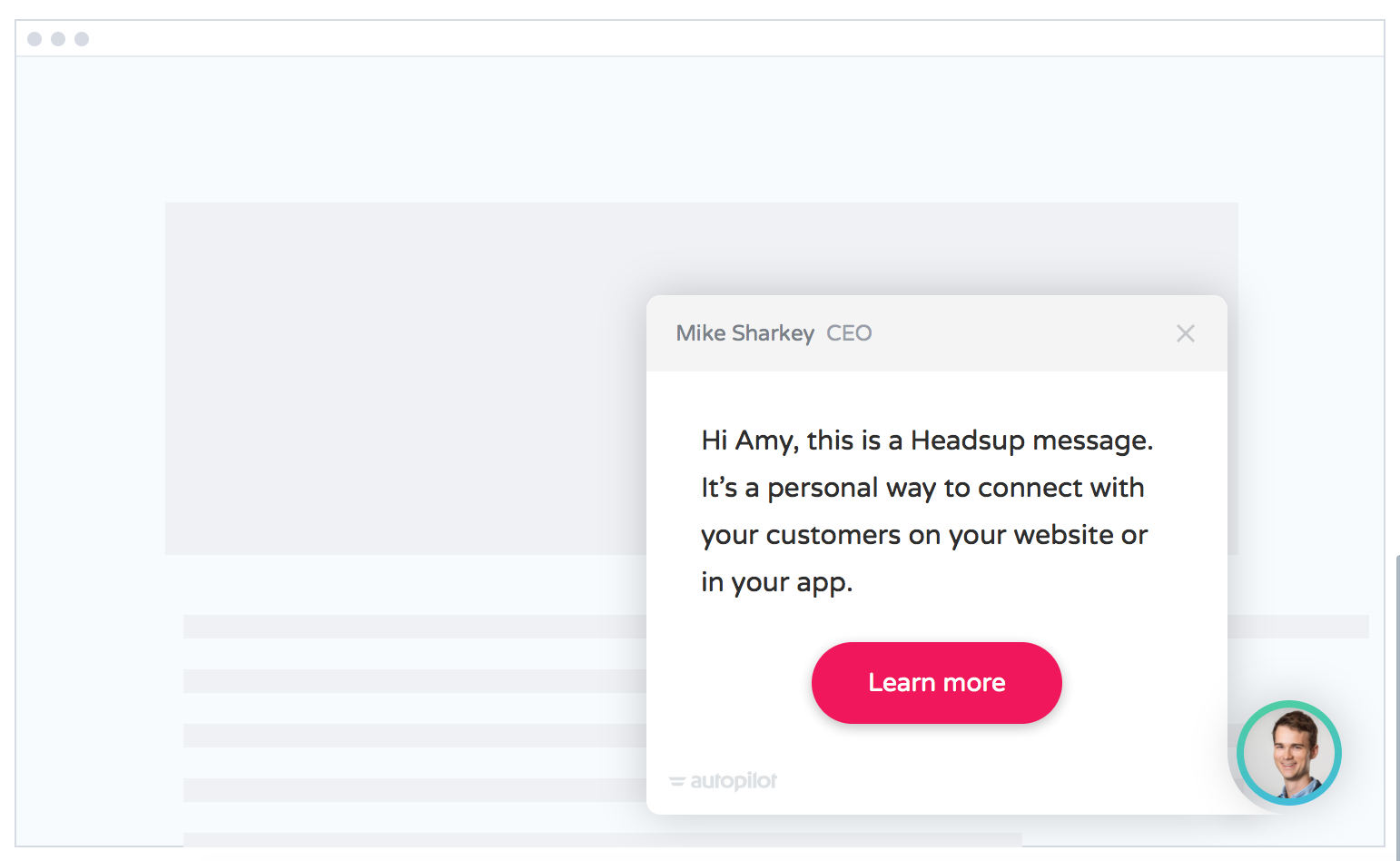
It allows you to show personalized messages to specific contacts on your:
- website;
- landing pages;
- blog;
- support site; or
- in your app.
Headsup messages are a part of your Journeys. This opens up many possibilities to send personalized, contextual messages to a contact based on:
- the Journeys they are in;
- actions they have taken; or
- their attributes.
Learn how Hint Health uses Headsup to create a killer user on-boarding experience here.
Who can I show Headsup messages to?
To ensure that Headsup messages are always personal and contextual, it's important to take into account thatmessages will only be shown to known contacts. Learn how a visitor goes from being anonymous to known here.
If you want to show Headsup messages to anonymous visitors before they are known, use Proactive Headsup.
How to Create a Journey with a Headsup Message
1. Setup your team members
Headsup messages are personal, and always come from a member of your team. So if you haven't yet setup your team, you can learn how to do so here.
2. Add the tracking code to the places you want to show Headsup messages
For web pages, learn how to add the tracking code here. You can add the tracking code in as many places as you like, including your website, landing pages, blog and support site.
For apps, learn how to add the app tracking code and implement user association here.
3. Create a Headsup message
Drop a Show Headsup Message action on the canvas:
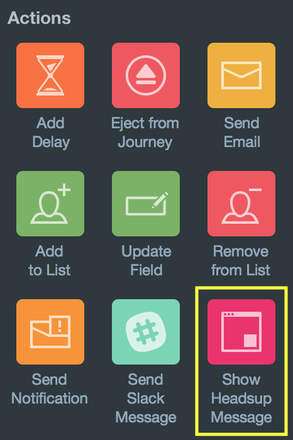
Click "New Message":

4. Name your message, and choose a message type
There are three message types:

The goal of each Headsup message is to get a contact to take a specific action:
- Call to action: click through to a web page
- Subscribe: subscribe to a list
- Reply-back: reply to your message
5. Customize where your message will appear
Select one of the following options:
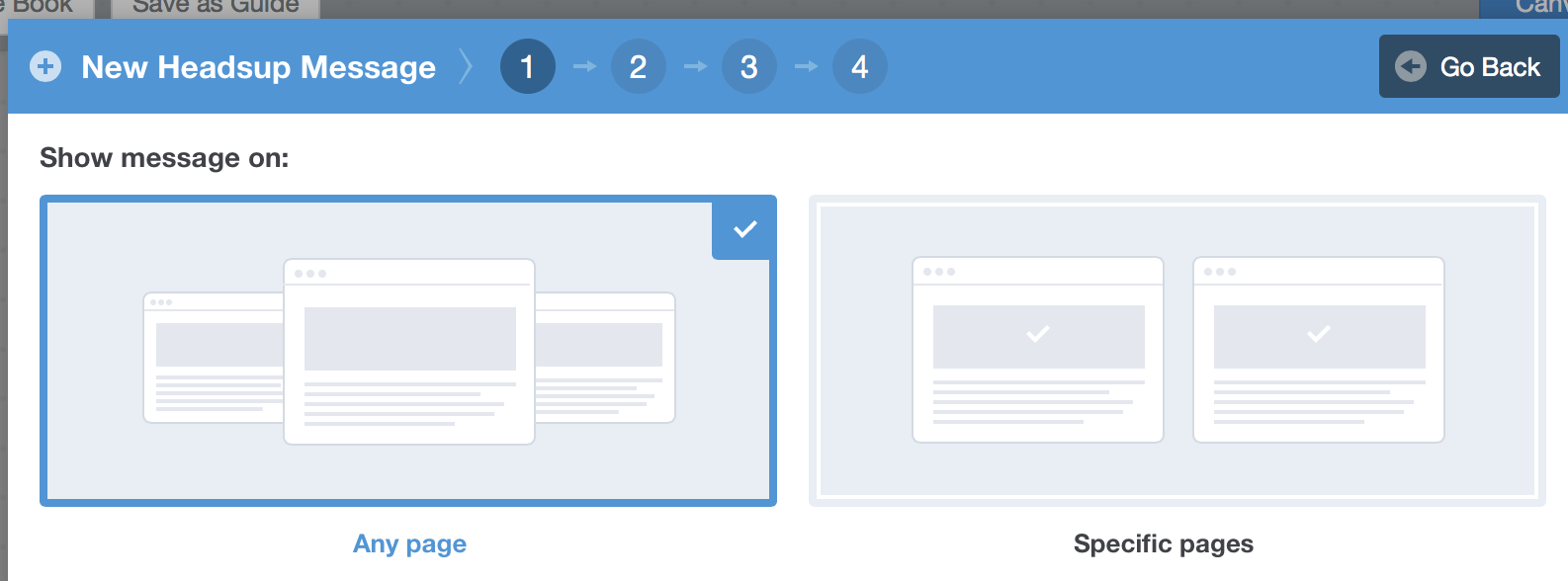
(a) Show the message on any page
The message will appear on any page that you have added the tracking code to.
(b) Show the message on specific pages
If you choose to only show the message on specific pages, you have the following options:
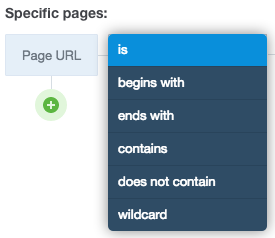
You can click the "+" button to add additional criteria:

To make targeting your messages easier, Headsup honors URL parameters. For example, if you were running a Facebook ad and had configured it to use a URL that contained UTM parameters, you could enter that URL in your message settings:

This would allow you to display a targeted message (e.g. an offer) only to those people that visit the page from that particular ad.
If you'd prefer to show a message to everyone that visits a page, regardless of whether it's via a URL with particular parameters, you can use the contains option:

Finally, please note that:
- You don't need to worry about adding variations for,, and. This is handled automatically.
- For wildcard formatting please see this article.
- If you've made a change to the above configuration for an existing message, you need to publish any Journey that uses the message to make the changes live.
6. Customize your message
Select the team member who the message will come from, and then customize your message, button text and button color (as necessary based on the message type selected):
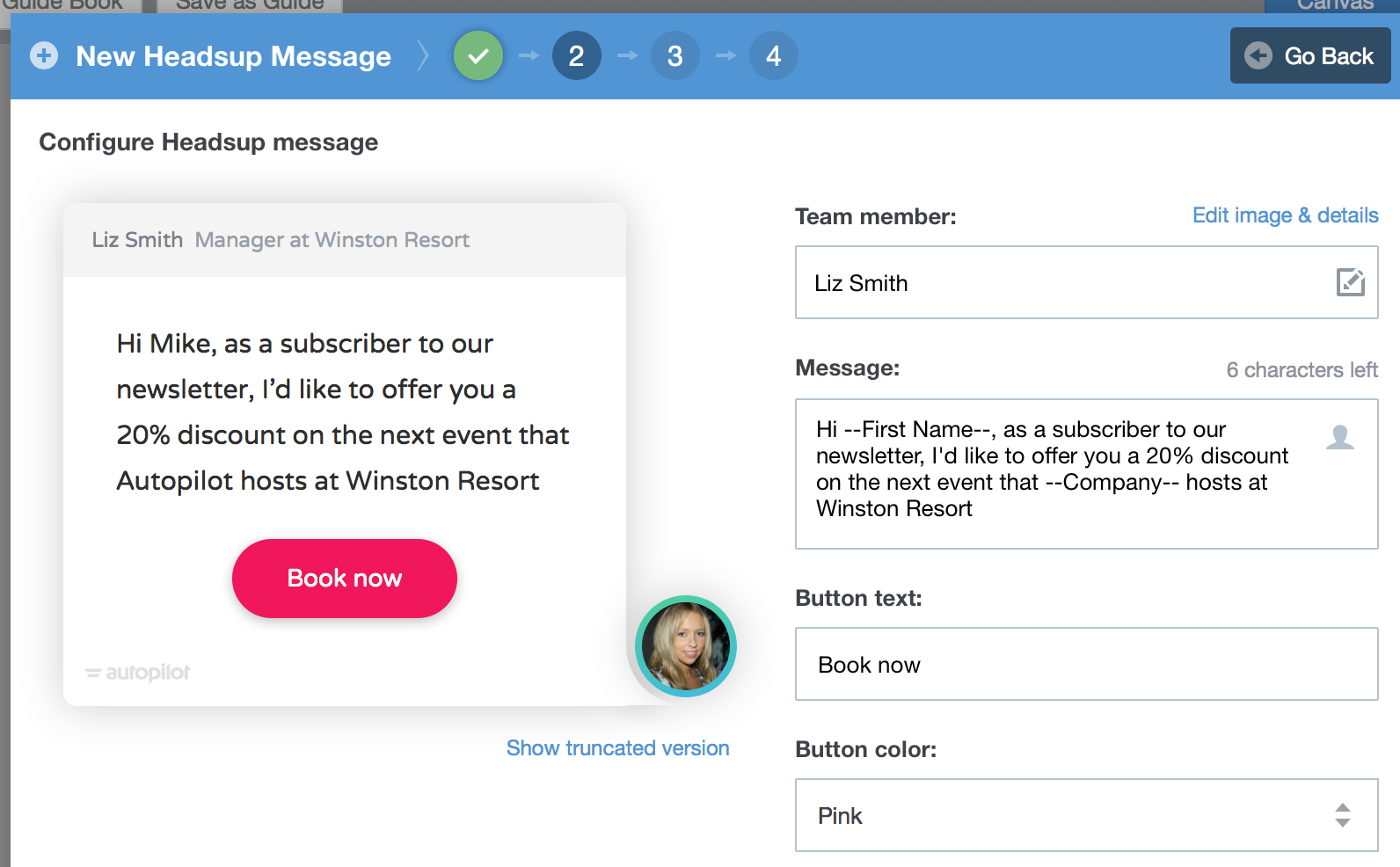
You can add personalization variables (both standard and custom fields are supported) to your messages by clicking this button:
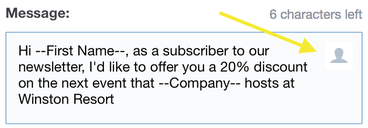
You can use fallbacks in Headsup messages, as well as in the button text. These are default values that will be inserted if the field is empty for the contact who enters the action. Fallbacks are formatted like this:
--variable=fallback--
Here are a couple of examples you might like to try:
- --First Name=there--
- --Company=your company--
7. Complete customization specific to each message type
This step varies based on the message type selected.
In Call to Action messages, the final step is to enter the page that the button will link to:
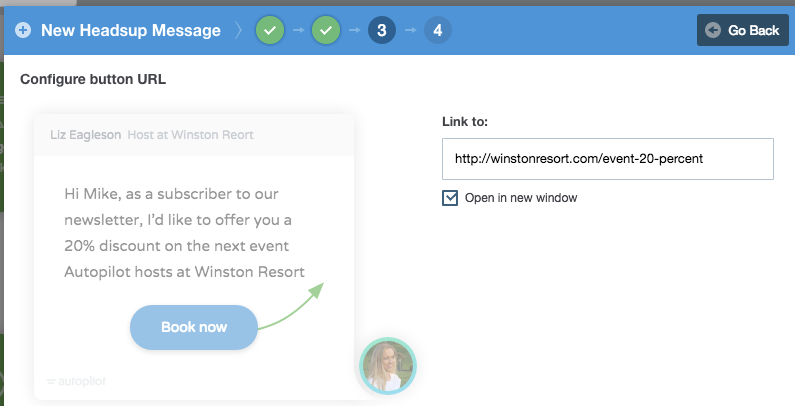
In Subscribe messages, you need to specify the list that contacts will be subscribed to:
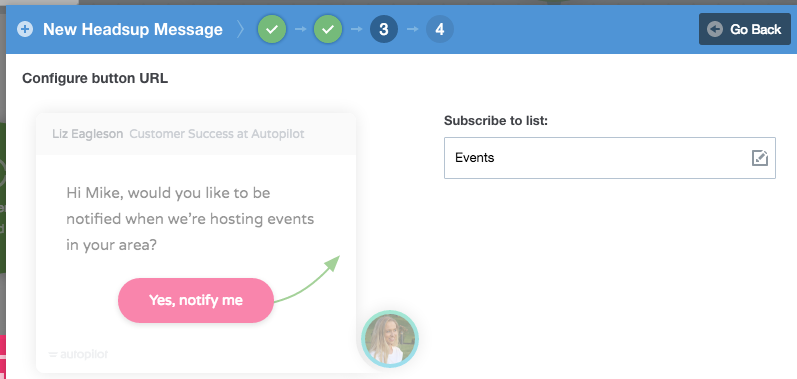
In Reply Back messages, you need to specify who will receive replies, and via which channel (either email, Slack, or both). The reply to the team member will be sent to the email associated with their user in the My Team settings. Note that in "Email the reply to others" you can enter multiple emails separated by commas:
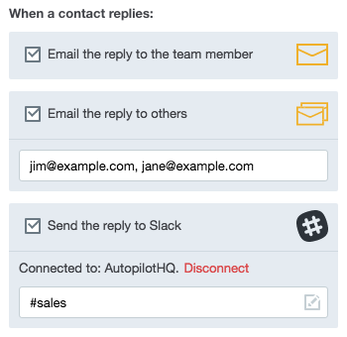
You can also add contacts that reply to a list, and save their reply in a custom field:
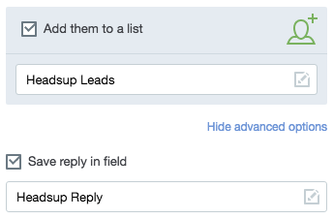
7. Configure message expiry
By default a message will:
- be displayed until a contact clicksdismisses it; and
- expire after 30 days (i.e. even if it hasn't been clicked or dismissed, it will no longer be shown to the contact). The time begins from when the contact enters the action.
You can change both of these defaults by clicking "Show advanced options":
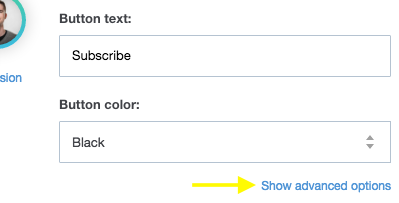
Changes to these settings will only apply to contacts that enter the actionyou publish the changes. If you want to stop showing a message before it expires, then you can either:
- stop the Journey; or
- remove the action and re-publish the Journey.
8. Build your Journey
There are many exciting ways you can use Headsup to enhance your Journeys.
Before you get started, it's important to take into account that in order for a Headsup message to be shown to a specific contact, Autopilot needs to know who they are. Learn how a contact goes from being anonymous to known here. With this in mind, below are some examples of Journeys that take full advantage of Headsup.
Example A: Display an offer after a contact submits a form
This Journey will show a Headsup message containing an offer to any contact who subscribes to a newsletter:

Example B: Ask a contact if they need help when they click through from an email
This Journey will show a Headsup message to contacts that click through from a pricing update email. The message asks if they need help:

Example C : Follow up a contact who submits a quote request
This Journey will show a Headsup message to contacts who haven't clicked through from a quote request email after two days:
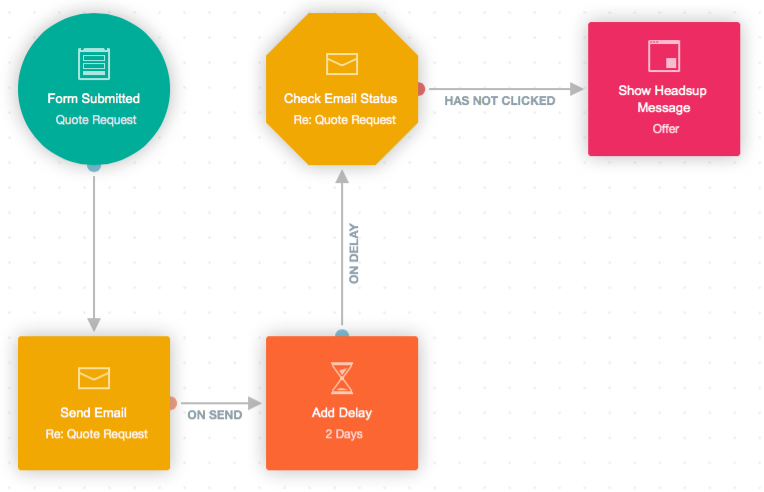
Outcomes and Activity Feed
The Show Headsup Message action has the following outcomes:
- On shown: when the preview of the message is initially displayed.
- On open: when the the contact hovers on the message, and it automatically expands to open.
- On response: when the contact takes the action the message asks them to. This varies based on message type. For example, a response in the call to action message type is a click on the button.
- On dismiss: when the contact closes the message by clicking the "X" in the top right.
- Continue: contacts will proceed to the next shape immediately, regardless of whether they are shown or interact with the message.
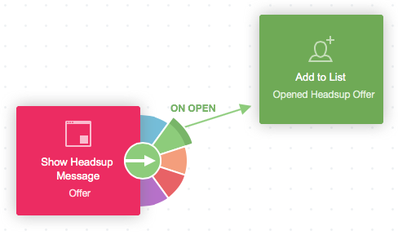
Note that, like email, the same contact can flow down multiple outcome paths. However, they will only flow down each type of outcome path (e.g. "on shown") once.
Each of the above mentioned outcomes will be displayed in the Activity Feed in real time. These feed items will tell you exactly what was shown to the contact. For example, here's an "open" feed item:

How to Manage Your Headsup Messages
To view and manage your Headsup messages, click on any Show Headsup Message action on the canvas and then click "Manage Existing":

In the manager, you can hover on a message to edit, duplicate (i.e. copy), view a report or delete:
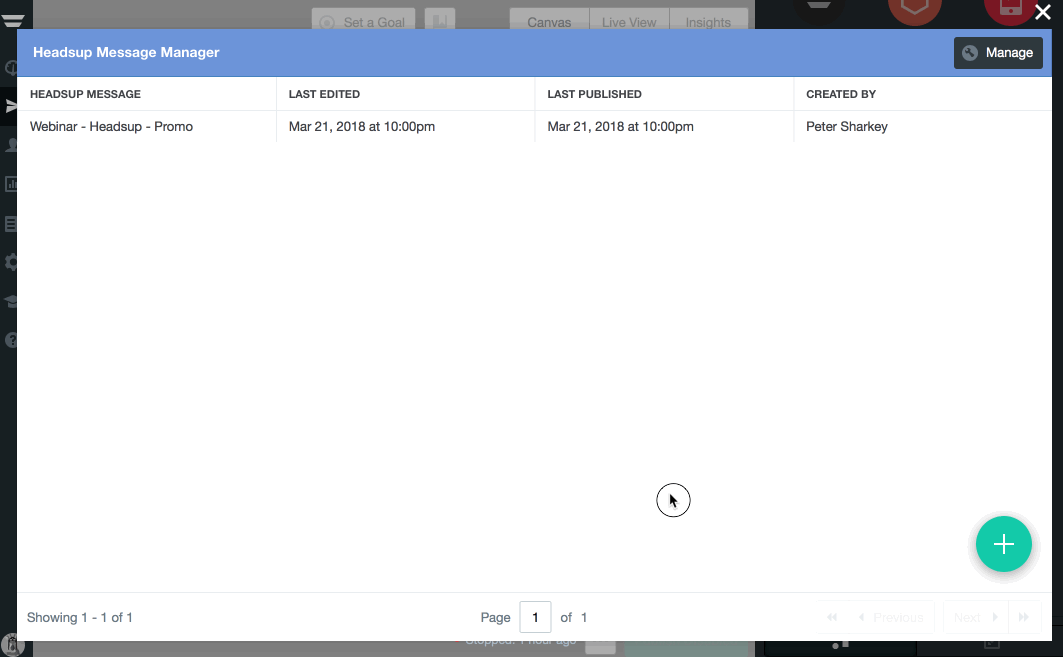
Clicking "Manage" will allow you to mass select and delete messages.
FAQ
How quickly will the message appear to the contact?
Please allow around 30 seconds for the contact to enter the Journey, and for the action to be executed. The message will then appear the next time the contact visits an eligible page.
What if a contact enters more than one Show Headsup Message action?
The action that a contact enters first will get preference.
However, if a contact enters two different actions, one configured to show a message on "specific pages" (Message A) and one configured to show on "any page" (Message B), they will be shown Message A on the specific pages, and Message B on any other page.
What if a contact enters a Show Headsup Message action more than once?
A contact will only be shown each Headsup message once. So if they enter an action with the same message selected again, they won't be shown it.
What if a contact enters the Show Headsup Message action before their session has been associated via a form submit or email click?
The message will be shown to the contact once their session has been associated.
What if I edit and re-publish my message after a contact has entered the Show Headsup Message action?
All contacts who see the message will be shown the edited message. Remember to publish your Journey after editing your message.
Why is there a character limit on Headsup messages?
Headsup messages are intended to be a simple and personal way to interact with your customers. Their design is based on extensive testing. We've therefore limited the character count to help you ensure your messages have the best possible impact.
Can I use Headsup in my web app?
Yes, please follow the instructions here to do so.
Are there reports for Headsup messages?
Yes. Just click into the Reports app, and then "Headsup Reports":
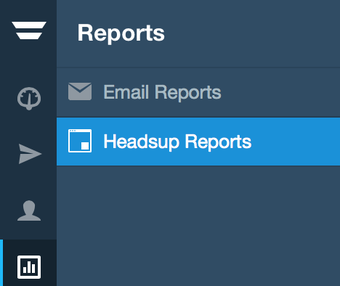
Learn more about Headsup reports here.
I've seen the term "eligible page" mentioned a few times, what does that mean?
By this we mean a page, or an app:
- with the Autopilot tracking code; and
- that meets the criteria (e.g. URL contains "product") for that particular Headsup message
Can I remove the Autopilot logo?
Yes, this option can be found under advanced options when creating your message.
Why does it show "Mike" in the Headsup preview when I use --First Name--?
We pre-fill some common personalization variables so you can get a better feel for what the final result will look like.
Can I sync Headsup activity with Salesforce?
Not currently, but you can vote on this idea here.
Can I create smart segments based off Headsup messages?
Not currently, but you can vote on this idea here.
Can I use personalization variables in the call to action link?
Not currently, but you can vote on this idea here.
Why not name it "Heads Up"?
We named this feature "Headsup" to make it something unique to Autopilot. But we thought we'd mention this in case you were searching for Heads Up instead.
